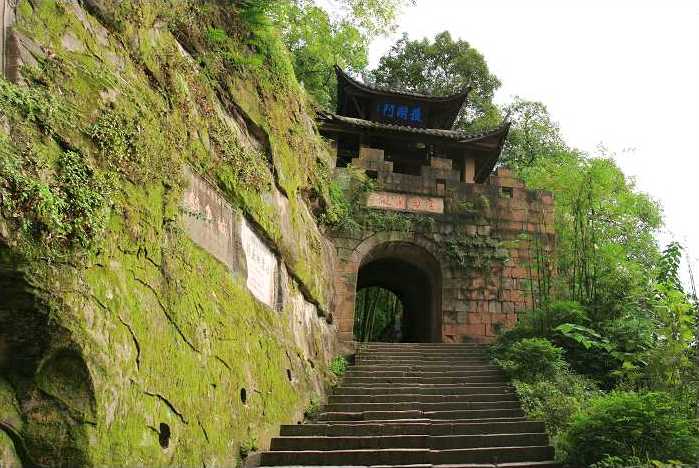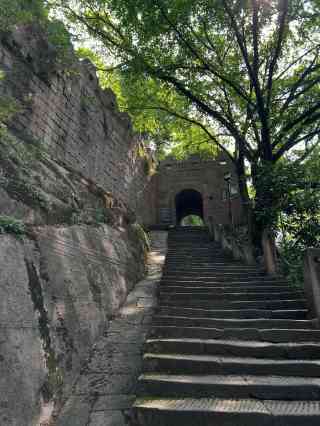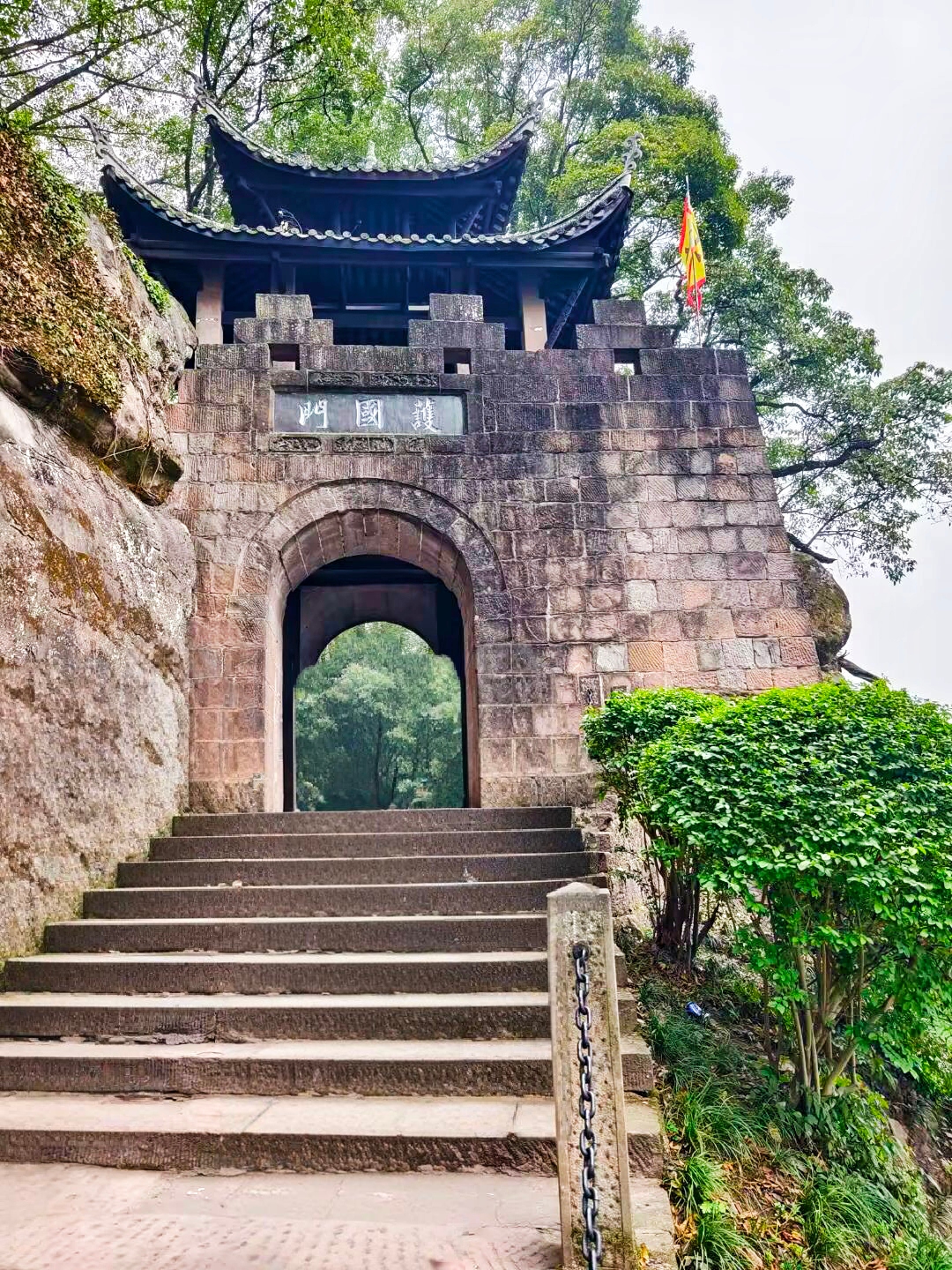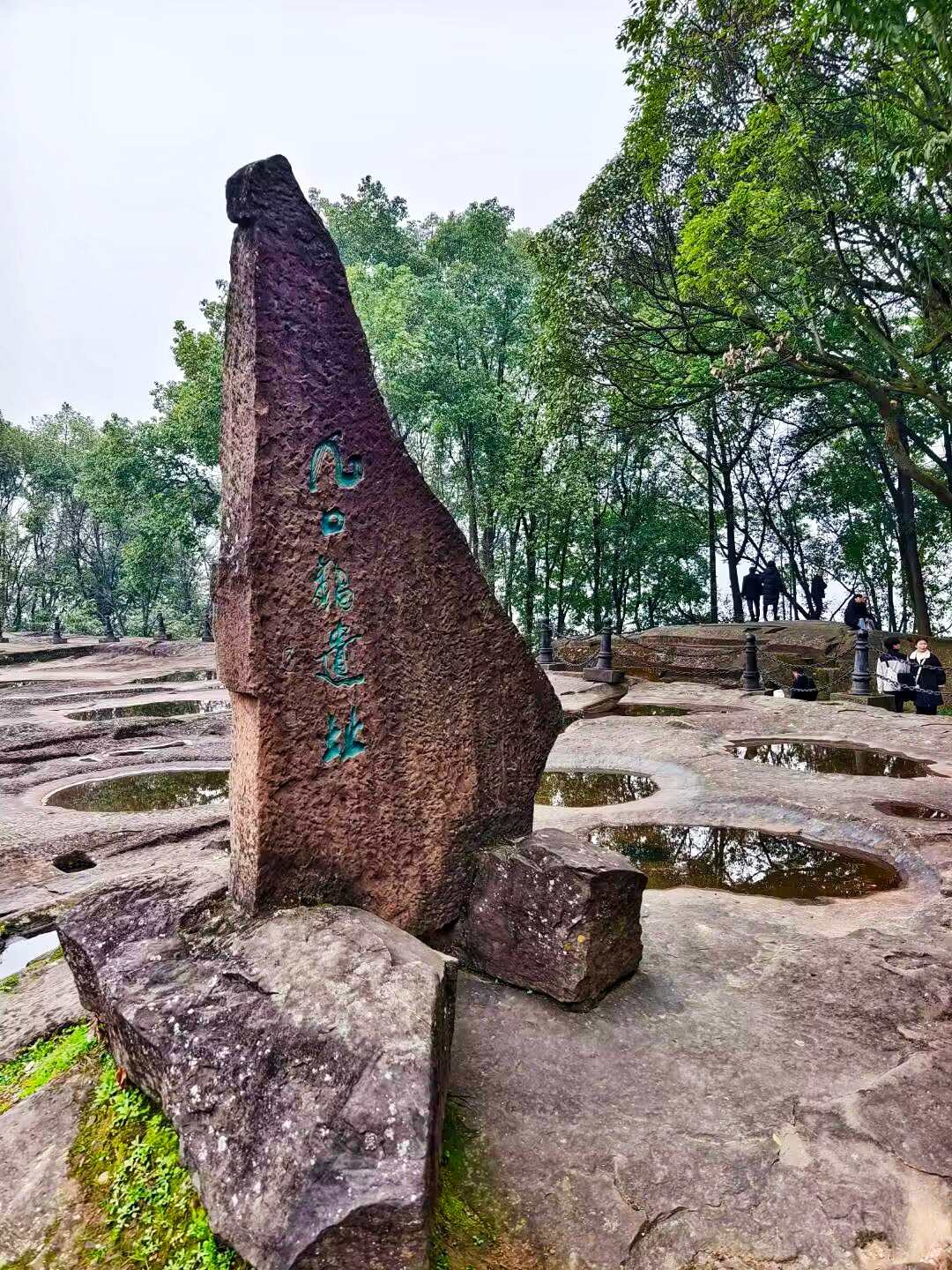Why Diaoyu Fortress Site Should Be on Your Travel Bucket List

An Essential Guide to Visiting Diaoyu_Fortress_Site
Nestled in the picturesque landscapes of Chongqing, the Diaoyu Fortress Site, also known as Diaoyucheng, is a remarkable testament to China’s rich history and resilience. This ancient garrison town, perched atop a hill and surrounded by the confluence of two rivers, is not just a place to visit but a journey back in time. Once a crucial battleground during the Song Dynasty, the fortress played a pivotal role in resisting the formidable Mongol armies, marking its significance in both Chinese and world history.
As you wander through its storied stone paths and weathered walls, you can almost hear the echoes of the past, where soldiers and civilians banded together to defend their homeland for 36 long years. The site is adorned with remnants of its glorious history, including ancient gates, temples, and breathtaking views that sweep across the lush green valleys below. Each corner of Diaoyu Fortress tells a story—of bravery, strategy, and the indomitable spirit of a people who shaped their destiny against insurmountable odds.
Visiting Diaoyu Fortress is not just about admiring its historical architecture; it’s an immersive experience that connects you to the natural beauty of the region and the cultural tapestry of China. Whether you’re an avid history buff, a nature lover, or simply seeking a unique adventure, this site promises a memorable exploration steeped in rich heritage and stunning scenery. As you prepare for your journey, let the allure of Diaoyu Fortress ignite your curiosity and set the stage for an unforgettable travel experience.
In This Guide
- An Essential Guide to Visiting Diaoyu_Fortress_Site
- The Rich History and Legends of Diaoyu_Fortress_Site
- Main Highlights: What You Absolutely Can’t Miss
- Planning Your Visit: A Practical Guide
- Tickets: Prices, Booking, and Tips
- How to Get There: A Complete Transportation Guide
- Local Cuisine and Accommodation Nearby
- Frequently Asked Questions
- Final Thoughts on Your Trip
The Rich History and Legends of Diaoyu_Fortress_Site
Nestled atop the rugged Diaoyu Mountain, the Diaoyu Fortress Site, or Diaoyucheng, stands as a testament to the resilience and valor of its defenders during one of the most significant eras in Chinese history. This ancient garrison town, located in Hechuan District of Chongqing, is not just a relic of the past; it is a vibrant narrative stitched into the very fabric of the Southern Song Dynasty’s struggle against the formidable Mongol Empire.
The fortress’s fame is primarily rooted in its role during the relentless siege that commenced in 1259. Under the leadership of the Mongol Khan, Mengge, an army of thousands laid siege to this strategic stronghold. For an astonishing 36 years, the inhabitants—soldiers and civilians alike—demonstrated unfathomable courage, resisting over 200 military clashes. Their tenacity reached a pivotal moment when Mengge himself was mortally wounded by artillery fire during the assault, leading to a power struggle within the Mongol ranks. This internal discord effectively halted their advance into the Southern Song territory and, as some historians argue, may have even spared Europe from Mongol expansion.
Walking through the remnants of the fortress today, visitors can explore the ancient walls that whisper tales of defiance and valor. While many structures have been restored, a portion of the original inner wall remains untouched, allowing one to stroll alongside history itself. The site is enveloped by lush greenery and offers breathtaking views of the surrounding mountains and rivers, creating a serene yet poignant atmosphere.
Beyond its military significance, Diaoyu Fortress is also a cultural landmark. It houses several Buddhist shrines and provides a glimpse into the region’s spiritual landscape, including artifacts from the Sino-Japanese War, as the site later served as a military training ground. This diverse historical context adds layers to the experience for visitors seeking more than just scenic beauty.
While the site remains relatively uncrowded compared to other tourist destinations, it does require some preparation for an enriching visit. Due to limited English-speaking guides, it’s advisable to either hire a local guide proficient in English or brush up on some historical context before your journey. As international travelers embark on their exploration of the fortress, they are not just viewing the remnants of an ancient military stronghold; they are stepping into the very heart of a legendary narrative that shaped the course of Chinese history.
In recent years, the site has garnered attention as a cultural hub, with events and festivals celebrating its rich heritage. As you traverse the pathways of Diaoyu Fortress, each step echoes with the stories of bravery and survival that have transcended time, inviting you to ponder the legacy of those who once stood their ground against overwhelming odds.

Diaoyu_Fortress_Site.
Main Highlights: What You Absolutely Can’t Miss
When visiting the Diaoyu Fortress Site, there are several remarkable highlights that you absolutely can’t miss. This ancient garrison town, steeped in history and natural beauty, offers a unique glimpse into China’s past, particularly its defiant stand against the Mongol invasions during the Song Dynasty. Here’s what to look out for:
1. The Historic Walls and Gates
The imposing ancient walls of the Diaoyu Fortress are a testament to its storied past. As you walk along the pathways, take the time to admire the reconstructed gates that guard the entrance. While some structures have been restored, the inner walls remain untouched and provide a genuine experience of walking alongside history. The views from these heights are breathtaking, especially with the lush greenery surrounding the site.
2. The Siege Battlefield
Step onto the very grounds where battles raged for over two decades. The site is famed for its resistance against the Mongol armies, particularly during the 23-year siege that ended with the death of Mongke Khan. This historic battlefield not only tells tales of valor but also offers stunning vistas of the confluence of the Jialing and Yangtze Rivers, enhancing the sense of drama that these ancient conflicts embodied.
3. Buddhist Shrines and Temples
Nestled within the fortress grounds are beautiful Buddhist shrines that date back to later periods. These temples add a spiritual dimension to your visit and provide a peaceful contrast to the site’s military history. The serene atmosphere here invites reflection, making it a perfect spot to pause and appreciate the harmonious blend of nature and architecture.
4. The Suspended Reclining Buddha
Don’t miss the opportunity to see the stunning millennium-old stone carving of a reclining Buddha. This impressive sculpture, set against the backdrop of the vibrant blue sky, is a photographer’s dream and a must-see for anyone interested in ancient art and spirituality.
5. Natural Trails and Scenic Paths
The fortress is set on the scenic Diaoyu Mountain, surrounded by rolling hills and lush forests. Take time to hike along the numerous trails that meander through the area. These paths not only lead you through the historical site but also offer tranquil spots to take in the stunning natural beauty and potentially spot local wildlife.
6. Interpretive Center
Although English information may be limited, the interpretive center provides valuable insights into the history of the fortress and the significance of the battles fought here. If possible, consider hiring a knowledgeable guide to enrich your experience with stories and context that bring the site to life.
7. Cultural Experiences
Engage with local culture by participating in traditional activities. You might find opportunities to wear Hanfu (traditional Chinese clothing) and try your hand at traditional games like Cuju (an ancient form of football). These immersive experiences will deepen your understanding of the region’s heritage.
8. Photographic Opportunities
The fortress, with its ancient architecture and scenic backdrop, offers countless opportunities for photography. Capture stunning shots of the walls against the rivers, the mist enveloping the mountains, and the intricate details of the temples. This is a visual feast for anyone looking to document their travels.
9. Local Cuisine
After exploring, indulge in local delicacies at nearby restaurants. Hechuan is famous for its pork slices and spicy mutton noodles. Don’t forget to try the sweet peach slices, a local specialty that serves as a delightful treat after a day of exploration.
10. Cultural Events
If your visit coincides with any festivals or cultural events, such as the Diaoyu City Tourism and Culture Festival, be sure to attend. These events, which often feature live performances, provide a lively atmosphere and a deeper appreciation of local traditions.
Visiting the Diaoyu Fortress Site is not just a trip into the past; it’s an adventure that combines history, culture, and natural beauty in one of China’s hidden gems. Make sure to take your time to explore and absorb the unique atmosphere that this remarkable site offers.

Diaoyu_Fortress_Site.
Planning Your Visit: A Practical Guide
Your Essential Guide to Visiting Diaoyu Fortress Site
Nestled atop Diaoyu Mountain in Hechuan District, Chongqing, the Diaoyu Fortress (钓鱼城) is a must-see destination for travelers who appreciate history, culture, and stunning natural landscapes. This ancient garrison town, famous for its valiant resistance against Mongol forces during the Song Dynasty, offers visitors a unique glimpse into China’s past. Here’s how to make the most of your visit.
Getting There
Location: Diaoyu Fortress is situated about an hour’s drive from downtown Chongqing.
Transportation Options:
– High-Speed Train: The quickest way to reach Hechuan from Chongqing is by taking a high-speed train, which takes approximately 30 minutes. Once you arrive at Hechuan Railway Station, you can take a taxi for the remaining 15-minute journey.
– Self-Driving: If you prefer more flexibility, renting a car is a great option. Navigate to “Hechuan Sports Center,” where you’ll find convenient parking available.
Best Time to Visit
While the site is open year-round, visiting during the spring (March to May) or autumn (September to November) is ideal. The weather is mild, and the natural beauty of the area, with its lush greenery and misty mountains, is at its peak.
What to Expect
Entry Fee: There may be a nominal entrance fee, so be prepared with cash, as card payments might not always be accepted.
Guided Tours: Due to the limited English-speaking resources available at the site, hiring a local guide who can speak English is highly recommended. They can provide invaluable insights into the history and significance of the fortress, ensuring you get the most out of your visit.
Exploration Highlights:
– Ancient Walls and Gates: Walk along the imposing walls and through the ancient gates, some of which have been restored while maintaining their historical essence.
– Buddhist Shrines: Discover serene Buddhist temples scattered throughout the site, offering a glimpse into the spiritual history of the area.
– Military History: Learn about the epic battles fought here, where local defenders held their ground against the Mongol Khan in a remarkable display of bravery.
Duration of Visit
Plan to spend about 2 to 3 hours at the fortress. This allows ample time to explore the ruins, take photographs, and enjoy the breathtaking views of the surrounding landscape.
What to Bring
- Comfortable Footwear: The paths can be slippery, so wear sturdy, non-slip shoes.
- Water and Snacks: While there are dining options nearby in Hechuan, carrying your own refreshments is a good idea, especially if you plan to spend a few hours exploring.
- Camera: The views of the Jialing River and the surrounding mountains are breathtaking, so don’t forget your camera or smartphone to capture the moment.
Local Cuisine
Make sure to try Hechuan’s local specialties, such as:
– Hechuan Pork Slices: A sweet and sour dish that’s a favorite among locals.
– Mutton Noodles: Spicy and aromatic, often garnished with fresh mint.
– Peach Slices: A soft and delightful dessert that’s not greasy.
Nearby Attractions
If time permits, consider exploring more of Hechuan:
– Laitan Ancient Town: Known for its Ming and Qing dynasty architecture and local delicacies.
– Dongjintuo Riverside Park: Perfect for a leisurely stroll by the river.
Important Tips
-
Crowd Management: If you’re visiting during a special event or festival, like the upcoming Diaoyu City Tourism and Culture Festival, arrive early to secure a good spot.
-
Clothing: Light-colored clothing is recommended for photo opportunities on the ancient city wall, as darker colors may not stand out against the backdrop.
-
Respect the Environment: As with any historical site, be respectful of the space and its artifacts. Follow local guidelines to preserve this important cultural heritage.
With its rich history, stunning scenery, and cultural significance, Diaoyu Fortress promises an enriching experience for international travelers eager to delve into the heart of China’s historical narrative. Plan your visit today and prepare to be captivated by the tales of resilience that echo through its ancient walls.

Diaoyu_Fortress_Site.
Tickets: Prices, Booking, and Tips
Visiting the Diaoyu Fortress Site is a journey into China’s rich history, and planning your trip with the right ticketing information can enhance your experience. Here’s everything you need to know about pricing, booking, and some helpful tips for your visit.
Ticket Prices
Entrance to the Diaoyu Fortress Site is generally affordable, making it accessible for international travelers. As of the latest updates, the ticket price is approximately ¥30 (around $4.50 USD). Keep in mind that prices may vary during special events or festivals, so it’s wise to check ahead if you’re planning your visit during peak seasons.
Booking Options
Tickets can be purchased on-site at the entrance of the fortress, but to ensure a smoother experience, consider booking in advance through local travel agencies or online platforms. Websites like Trip.com or local tourism boards often provide options for advance booking and may offer package deals that include guided tours or transportation.
Guided Tours
Due to the limited English-speaking resources at the site, it’s highly recommended to join a guided tour. Hiring a local guide not only provides you with valuable insights into the history of the fortress but also enhances your overall experience. Many guides are fluent in English and can help navigate through the site’s significant landmarks, including the ancient walls and the interpretive center.
Tips for Your Visit
-
Wear Comfortable Footwear: The terrain can be uneven and slippery, so sturdy, non-slip shoes are essential for exploring the fortress trails.
-
Timing Your Visit: To avoid crowds, consider visiting early in the morning or later in the afternoon. Midday can be particularly busy, especially during weekends and holidays.
-
Bring Water and Snacks: While there are limited dining options nearby, bringing your own refreshments will ensure you stay energized as you explore the expansive grounds.
-
Check for Special Events: The fortress occasionally hosts cultural festivals or events that can enrich your visit. For instance, the Diaoyu City Tourism and Culture Festival in June is a great time to enjoy local performances and activities.
-
Photography: The natural scenery surrounding the fortress, combined with its historical architecture, provides stunning photo opportunities. Light-colored clothing can help you stand out against the beautiful backdrop of the ancient city walls.
With these tips in mind, you’re all set to embark on a captivating journey through the Diaoyu Fortress, an unforgettable highlight of your travels in Chongqing!
How to Get There: A Complete Transportation Guide
Reaching the historic Diaoyu Fortress Site, nestled in the scenic Hechuan District of Chongqing, is a journey worth undertaking. Here’s a comprehensive guide to help you navigate your way there seamlessly.
Getting to Chongqing
By Air
Most international travelers will likely arrive in Chongqing Jiangbei International Airport (CKG), which is well-connected to major cities around the globe. Upon arrival, you have a couple of choices for getting to the city center:
- Taxi: Taxis are readily available at the airport and provide a quick option to reach downtown Chongqing. Expect the ride to take around 30 minutes to an hour, depending on traffic.
- Airport Shuttle: There are shuttle buses that connect the airport to various locations in the city, which can be a more economical option.
By Train
If you’re already in China, high-speed trains are an excellent way to reach Chongqing. The city’s main railway station is Chongqing North Railway Station, which links to major cities like Beijing, Shanghai, and Xi’an.
From Chongqing to Diaoyu Fortress
Once you’re in Chongqing, getting to Diaoyu Fortress involves a bit of travel but is straightforward:
By High-Speed Train
- To Hechuan Station:
- Board a high-speed train from Chongqing North Railway Station to Hechuan Railway Station. The journey lasts approximately 30 minutes.
- From Hechuan Railway Station:
- After arriving at Hechuan Railway Station, you can take a taxi to Diaoyu Fortress. The taxi ride should take about 15 minutes, depending on traffic.
By Car
For those who prefer self-driving, you can rent a car or use a ride-hailing service. Simply navigate to “Hechuan Sports Center” for convenient parking options nearby. The drive from downtown Chongqing to Diaoyu Fortress takes around an hour, allowing you to enjoy the beautiful countryside along the way.
Tips for Your Visit
- Language Barrier: It’s advisable to arrange for an English-speaking guide, as English is not widely spoken in the area.
- Footwear: The fortress area has many steep paths and steps, so wear comfortable, non-slip shoes for your exploration.
- Weather Considerations: The location is often misty, adding to its mystique, but do check the weather forecast and prepare accordingly.
With the right planning and this guide in hand, your journey to the remarkable Diaoyu Fortress Site promises to be both smooth and enriching! Enjoy your adventure through history in this ancient stronghold!

Diaoyu_Fortress_Site.
Local Cuisine and Accommodation Nearby
When visiting the Diaoyu Fortress Site, immerse yourself not only in the rich history but also in the delightful local cuisine and comfortable accommodations that Hechuan has to offer.
Local Cuisine
Hechuan is renowned for its unique culinary delights, and no visit is complete without sampling some of the region’s signature dishes:
-
Hechuan Pork Slices: This dish is a must-try for its sweet and sour flavors that tantalize the taste buds. Often served with fresh vegetables, it’s a great introduction to local tastes.
-
Mutton Noodles: A local favorite, these noodles come in a spicy broth infused with fresh mint leaves. The robust flavors and hearty ingredients make this dish particularly satisfying.
-
Peach Slices: For dessert, indulge in Hechuan’s famous peach slices, known for their soft texture and light sweetness. They make for a perfect ending to your meal.
-
Street Food Stalls: Explore the vibrant street food scene around the fortress and nearby areas. From grilled skewers to savory pancakes, the local vendors offer a variety of snacks that are perfect for a quick bite while you explore.
Accommodation Options
After a day of exploring the historic fortress, unwind at one of Hechuan’s charming accommodations:
-
All Seasons Hotel: Located conveniently near the Hechuan Sports Center, this hotel offers modern amenities with a touch of local hospitality. It’s ideal for travelers looking for comfort and accessibility.
-
Laitan Ancient Town Homestay: For a unique experience, consider staying in a homestay in Laitan Ancient Town. Enjoy a river view room and experience the enchanting ambiance of the ancient town at night. This option allows you to soak in the local culture and tranquility.
-
Hechuan Guesthouses: There are various guesthouses scattered throughout the area that offer cozy rooms at reasonable prices. Many of these establishments provide a more intimate setting, allowing you to connect with local hosts and gain insights into the culture.
Tips for Your Visit
- Dining Hours: Many local restaurants serve lunch and dinner, but it’s a good idea to check opening times, especially for smaller eateries.
- Reservations: For popular spots, especially during peak seasons or festivals, making a reservation can ensure you have a table waiting for you.
- Local Markets: Don’t miss out on visiting local markets for fresh produce and authentic street food. It’s a great way to experience the community vibe.
With an array of delicious food options and welcoming places to stay, your visit to the Diaoyu Fortress Site will be as enriching as it is enjoyable.

Diaoyu_Fortress_Site.
Frequently Asked Questions
Frequently Asked Questions about Diaoyu Fortress Site
-
What is the significance of Diaoyu Fortress?
Diaoyu Fortress, also known as Diaoyucheng, is a historic site famous for its successful resistance against the Mongol armies during the Song Dynasty. It is a symbol of resilience and played a crucial role in shaping Chinese history. -
How do I get to Diaoyu Fortress from Chongqing?
The fortress is located approximately 1.5 hours from downtown Chongqing. You can take a high-speed train to Hechuan, which takes about 30 minutes, and then a taxi for a 15-minute ride to the site. Alternatively, self-driving is also a convenient option. -
Is it necessary to hire a guide when visiting?
While it is possible to explore the site independently, hiring a guide is highly recommended, especially one who speaks English. Many historical details and context might be missed without a knowledgeable guide, as English signage is limited. -
What are the opening hours of Diaoyu Fortress?
The fortress is open 24 hours a day, making it convenient for visitors to explore at their own pace. However, it’s best to visit during daylight hours for safety and to fully appreciate the scenery. -
What should I wear when visiting the fortress?
Dress comfortably and wear sturdy, non-slip shoes, as the paths can be slippery and uneven. Light-colored clothing is recommended for better visibility in photographs, especially when capturing the ancient city walls. -
Are there any facilities available on-site?
Diaoyu Fortress has basic amenities like restrooms and an interpretive center, but it’s advisable to bring your own snacks and water, as options may be limited within the site. -
What is the best time of year to visit?
The best time to visit is during the spring (March to May) and autumn (September to November) when the weather is mild and pleasant. These seasons also provide stunning views of the surrounding landscape. -
Can I find accommodations nearby?
Yes, there are several options in the Hechuan urban area, including budget hotels and homestays. For a unique experience, consider staying in Laitan Ancient Town, which offers charming river view rooms and a taste of local culture.
Final Thoughts on Your Trip
As your journey to Diaoyu Fortress comes to a close, it’s impossible not to feel a profound connection to the rich tapestry of history that envelops this ancient garrison town. Perched majestically atop the hills of Chongqing, the fortress is not merely a site of stone and earth; it is a living testament to the courage and resilience of those who once defended it against the mighty Mongol forces.
Walking through the remnants of the ancient walls, you can almost hear the echoes of the past—the clash of swords, the cries of the defenders, and the whispers of the wind that has witnessed centuries of change. The beautiful landscapes that surround the fortress, with rivers meandering gracefully at its feet, create a serene backdrop, inviting contemplation and reflection.
Engaging with this historical site offers international travelers a unique glimpse into China’s storied past, as well as a chance to experience the tranquil beauty of its natural surroundings. Whether you’re exploring the winding paths, admiring the restored structures, or taking a moment to pause at one of the Buddhist shrines, every corner of Diaoyu Fortress tells a story worth hearing.
As you leave, carry with you not just memories of the stunning vistas and ancient architecture, but also a deeper appreciation for the enduring spirit that defines this remarkable place. Your adventure here is a reminder that history is not just found in books—it’s alive in the landscapes we traverse and the stories we uncover. Until your next journey, may the echoes of Diaoyu Fortress inspire you to seek out the tales hidden in every corner of the world.